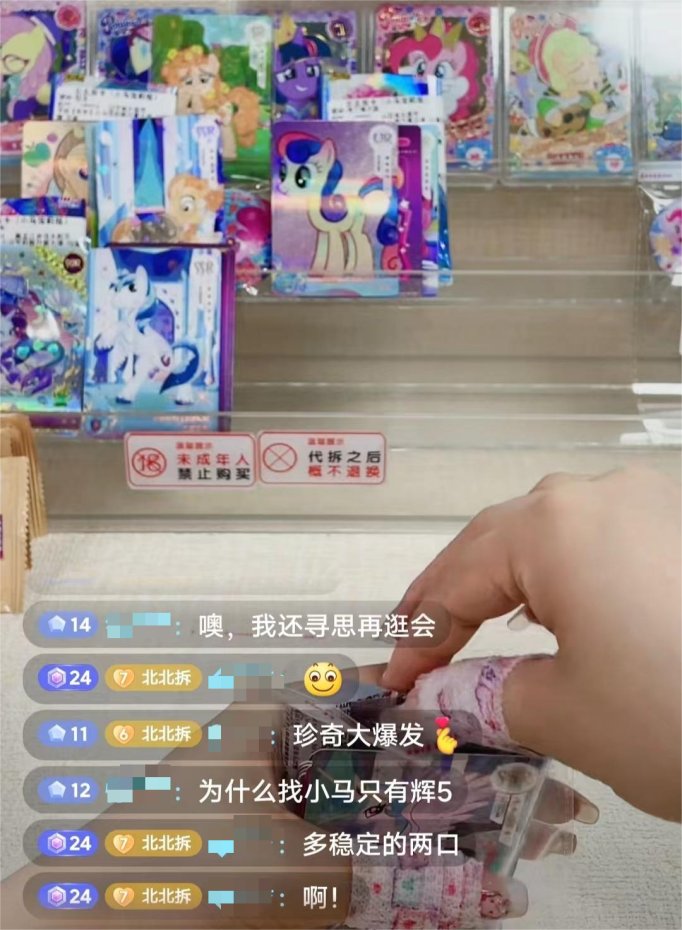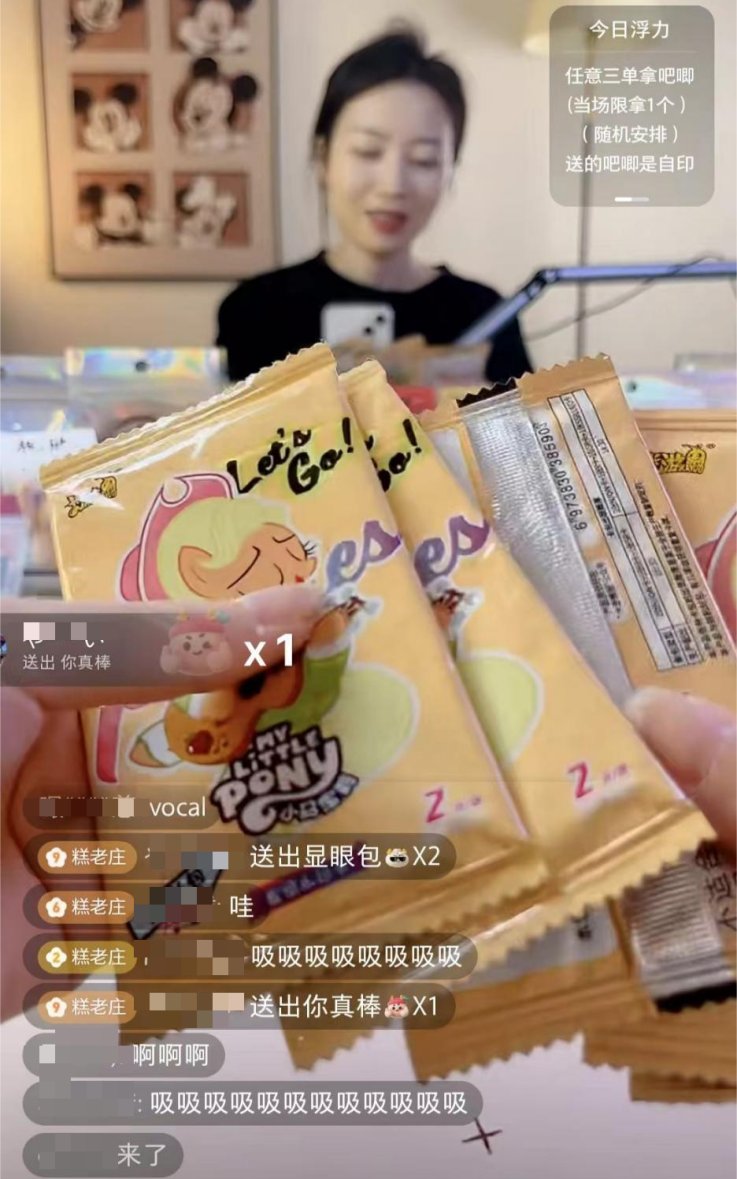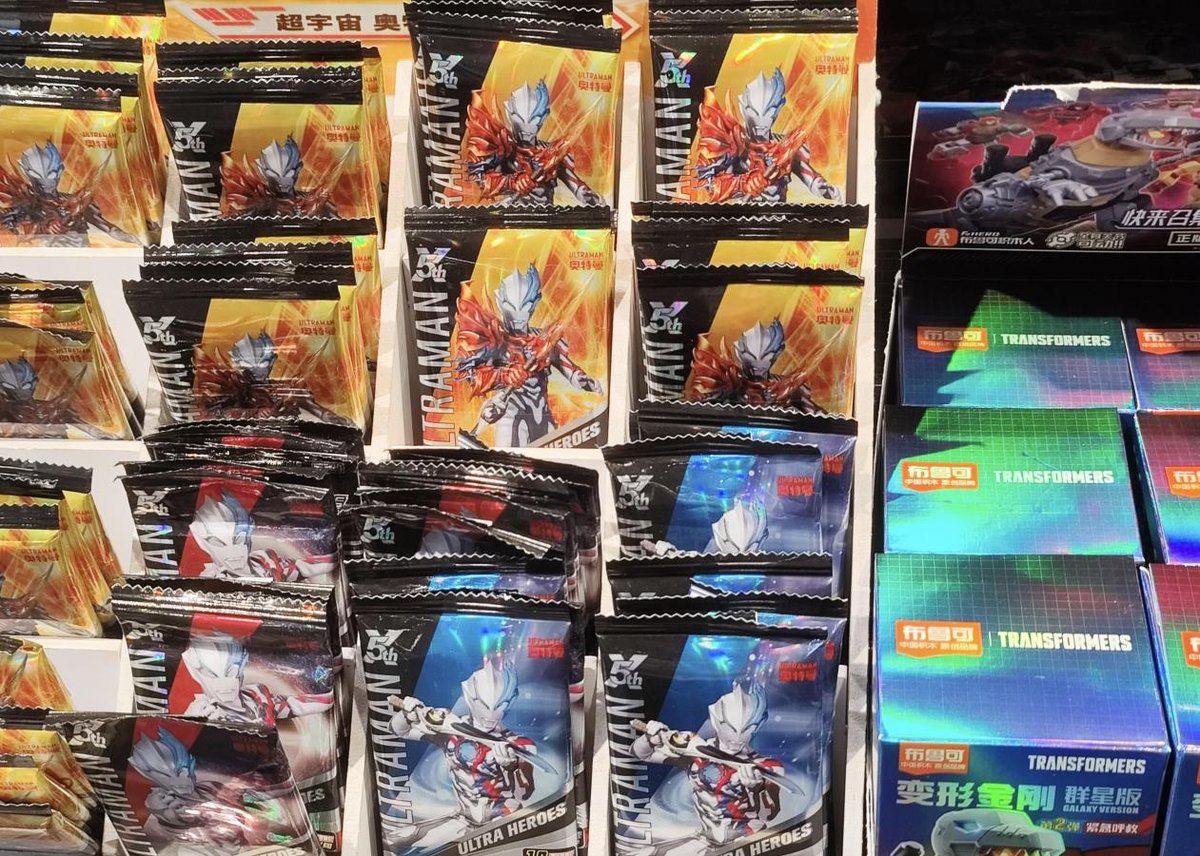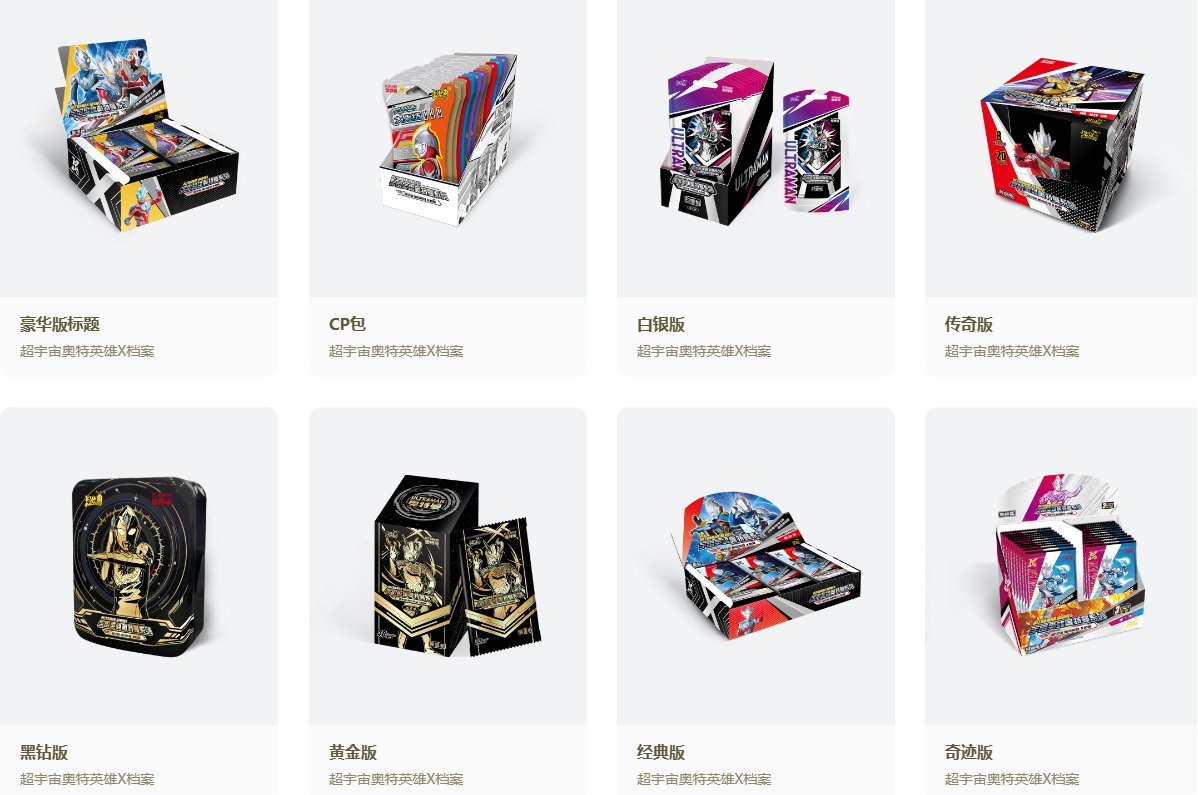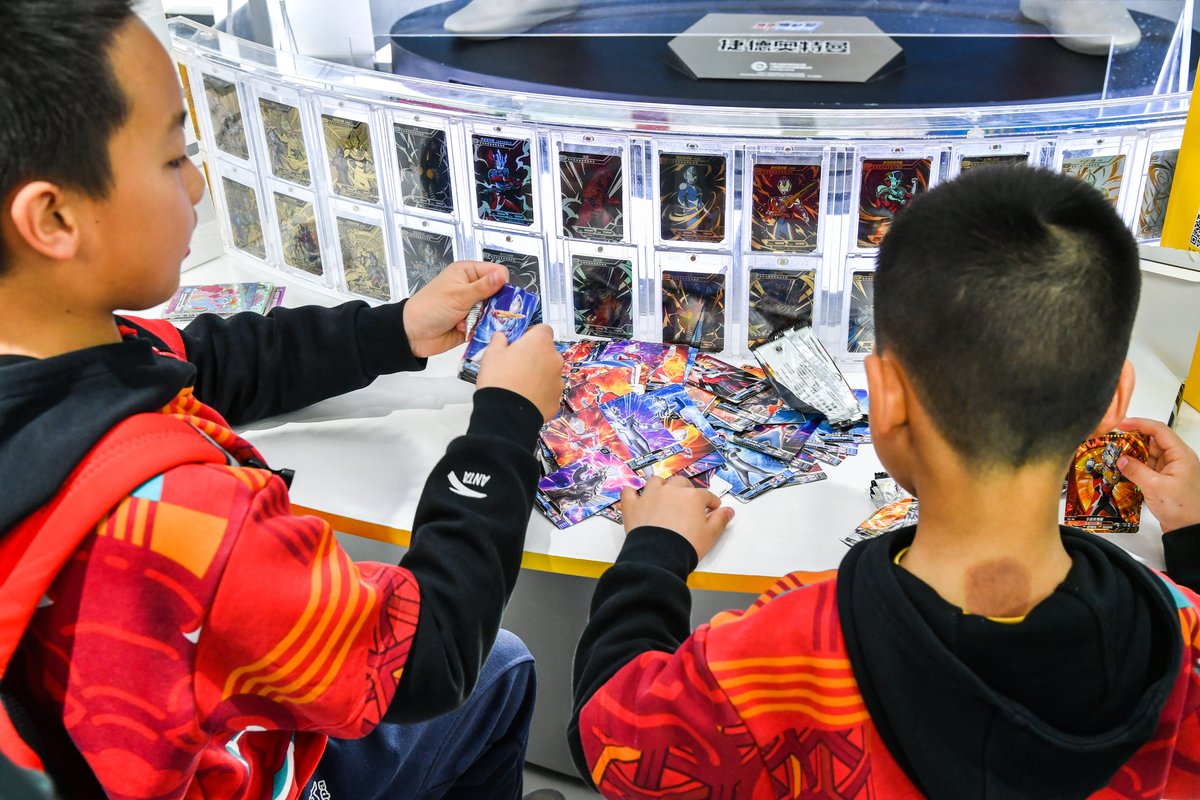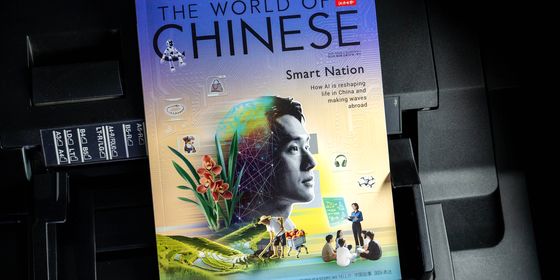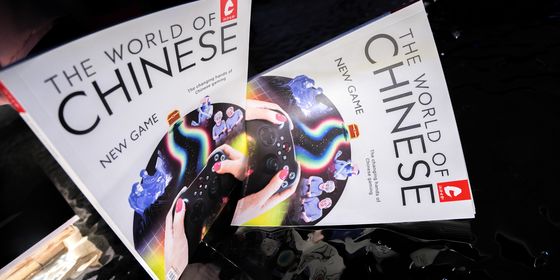Is the latest card craze an unhealthy addiction for children or a lifeline for small-town shop owners?
Douyin, China’s version of TikTok, is witnessing a new craze.
A livestream channel, a pair of scissors, and an acrylic rack with packs of cards lining the shelves. The host doesn’t even need to show their face to draw an audience of thousands.
On the surface, what’s being sold are the cards, which are printed with characters from various well-known games and shows and not revealed until the host opens the pack. But as the viewer numbers skyrocket, it’s clear that luck is the real commodity here. Some people get the card they want on the first try; others have bought three packs and still no luck. On the screen, a message warns, “Minors Prohibited from Buying”—confirming, therefore, that many of the viewers are underage.
Gen Z may have gone crazy for Pop Mart figurines—sets of collectible toys, the design of which are unknown to the buyer until they’ve paid and opened the box—but for the generation next in line, it’s all about collectible cards. There’s plenty of profit in this craze, leading Chinese collectible toymaker Kayou Inc. to file for a Hong Kong IPO in late January last year. It is expected that they will make their debut in the stock arena soon.
Gen Alpha kids don’t constrain their obsession to the online realm. Convenience stores that sell these cards near schools have witnessed it too. The rationale is simple: Everyone is buying them; you don’t want to miss the boat. The rarer the card, the more attention you get from your peers.
Show me your best card: a high-stakes livestream
“If I miss out on a livestream, I would feel anxious all day,” says Fang Si, a Chinese third-grader.
Fang isn’t exaggerating. Every livestream presents her with a legitimate rush of dopamine. There’s a proper ritual going on, if a frenzied one: A pack of cards is shown to the audience before the packaging is neatly cut, and each card is laid out on the clear acrylic rack according to its rank. It’s easy for a little girl like Fang to get addicted, and every day after school she will religiously ask her mother for one hour of tablet use, which she spends glued to a series of Douyin channels dealing with these objects of generational desire.
These hauls aren’t just advertisements for cards. Instead, they rely on elements similar to gambling to lure an audience hoping to make the most bang for their buck. Fang is well acquainted with the countless ways these riveting livestreams unfold. Buyers playing a game of “stacking” draw a card and, depending on the outcome, they may have to buy another one. The more you buy, the more you stand to gain...or lose. The “piercing” game entails drawing a rare card, which the lucky winner must redeem by buying an entire box of cards. To play “hide and seek,” you keep buying and opening packs until a specific character pops up.
Needless to say, not all cards are priced the same. In the My Little Pony collectible series, a pack will go for about 25 yuan during a game of stacking, while the retail price set by the company is 10 yuan per pack. Get lucky and you could buy one pack and stack up to 50 in a game. Conversely, it might as well be game over for you right after your first pack.
There is a running joke in the industry that you don’t play these card games with your hands; it’s all about chasing thrills. Livestreamers know how to entice their young audience. As scissors cut through the packaging, the host announces: “Time to unbox the golden sponsor crate!”
There’s a series of power dynamics in this terminology. Golden sponsors are those who buy a whole crate of cards all in one go. In Fang’s eyes, this is a symbol of wealth and status. After all, there’s no way she could afford that with her weekly allowance of 20 yuan from her parents. There are 48 boxes from the My Little Pony series in tonight’s crate, with a total of 48 packs and 1,440 cards. That’s a whopping 2,640 yuan. Even if Fang never spent a cent of her pocket money, nor the money her grandparents sometimes give her on the sly, she would still have to save until her elementary school graduation in order to afford this crate.
Livestreams like this are so riveting because no matter whether you come from a well-to-do household or a modest family, it’s all a game of chance. Tonight’s player only wants cards in the range of “SSR” (Super Super Rare), so anything below that doesn’t ever make it to the rack. Instead, the livestreamer will just toss them into the discarded cardboard box. Tonight, only four cards have made it to the rack. Fang sighs; it must be nice to be this rich. If only her parents could earn a bit more.
Though the audience is still holding their breath on the remaining half of the crate, Fang’s daily hour online is over. It’s time to hand over the tablet to her mom, who has previously blocked all payment channels on the device, lest her daughter try and sneak in an order. Fang saves her modest allowance, and her sister helps her place the occasional order when she’s home from college. She’s mortified. All her classmates are allowed to use their parents’ accounts to buy, and they won’t get scolded if they don’t spend more than 20 or 30 yuan.
Fang has a plan: For summer vacation, she’ll go stay with her grandparents, where she’ll be able to register an account using their ID numbers and score herself some new cards.
Ultraman cards as social currency
The grip of Kayou Inc. over their young customers has spread to a tiny convenience store outside an elementary school, barely 10 square meters in area. As soon as the dismissal bell rings, kids rush in to buy cards. Haohao, a second-grader, is one of them. He has pushed his way through the crowd and is now looking at the cabinet, a treasure trove where the Ultraman cards dazzle at him from their place of honor. Haohao doesn’t have much time, but he still tries his best to choose the right pack of cards before another eager kid tells him to get a move on.
Haohao feels hopeful; today is surely his lucky day. “I am going to find Ultraman Zero’s USR-card.” In the context of collectible cards, USR denotes the ultimate card, the one item of the collection that everyone hopes to score.
Unfortunately, this is literally not in the cards for Haohao today. He’s clearly disappointed as he flips from one card to the next. “Oh, come on! It’s the third time I’ve got a repeat! They aren’t even all that special...”
He can only stuff the bunch of cards in his schoolbag and hope for his miracle tomorrow. And Haohao does believe in miracles, because Ultraman has taught him to do so. “Ultraman is our eternal hero. He will always be there for me, just as long as I keep the light in my heart.”
Adults long for a fateful lottery ticket that will let them lay down their burdens and never work another day. It’s not all that different for Gen Alpha kids with their collectible cards. They just crave attention and admiration from their peers. Haohao has learned to see his Ultraman cards as a social currency. “You know? I buy them so that my friends will look up to me.”
Nine out of 10 boys in Haohao’s class keep Ultraman cards in their school bags. Kayou Inc. regards the Ultraman series as its flagship product, the true pillar of the company. It has sold 3 billion yuan so far, accounting for 65 percent of its sales revenue. In other words, over 6 out of every 10 packs sold by Kayou Inc. belong to the Ultraman series.
Ultraman cards branch out into their own hierarchy, spanning more than 20 categories depending on their craftsmanship: Rare, Super Rare, Super Super Rare, Legend Rare, Ultra Super Rare, Gold Parallel, and Extra Rare. The rarer your cards, the higher your status as a Gen Alpha kid.
It’s possible that kids like Haohao crave a feeling that is otherwise scarce in their daily lives. Every time a schoolmate greets him as “Big Brother Hao,” just because he’s carrying around a thick album of cards, Haohao feels validated, admired, and loved. This is a far cry from his father’s less-than-affectionate nickname for him: brat. At school, the acceptance from his peers renews Haohao’s belief in Ultraman’s inspirational mantra. “I have the best cards in the class, so kids I don’t even know come to me and we talk cards together.”
Haohao knows his way around the Ultraman card series so that whenever he gets a card that he doesn’t like, he can often sell it to his buddies for a low price. He doesn’t get to keep the money for long. Whatever meager profit he makes line the pockets of the convenience store owner in exchange for more cards. Haohao buys them for a whole week before finally scoring the card he’d set his eyes on. He is delighted and immediately adds his new treasure to his album with the utmost care. “I’ve completed the Ultraman USR series! I’m taking the album to school with me tomorrow!”
A lifeline for rural businesses?
Away from China’s urban hubs, the card craze has given a lifeline to many rural stationery shops that cater to school kids. This was the case for Tang Xiao, the owner of one such shop. Though her business is not far from a township elementary school, it is located at the end of a winding road where few students would pass. Tang is used to fretting her days away at an empty store. “It’s been less than a year since I took over this lease. I invested a lot in renovations and inventory. If I give up now, I can kiss my money goodbye.”
Tang has been racking her brains about potential business strategies, including discounts, freebies for larger purchases, and even flyers at the school gate. Nothing worked until her niece shared a crucial piece of information with her: Her classmates were pining for these anime-themed cards that they’d seen online. Unfortunately, they were nowhere to be found in their small town.
Tang’s entrepreneurial instinct tingled, and she drove to the county town that same weekend. When she saw the store shelves there all lined with those cards, she sighed with relief; her business was saved.
The next step was finding a wholesale supplier. When Tang visited the warehouse, another shop owner was there, happily ordering five large crates. “Kids go crazy over those dang cards nowadays. I’m making thousands a day just from these alone!”
Their tales of riches made Tang jealous, but she was still conservative in her estimations; this was terra incognita for her. Eventually, she let other shop owners recommend the bestsellers: a trio featuring Ultraman, The Fairy Dream of Yeloli, and My Little Pony. The wholesaler offered her 60 percent off on a total of six crates of cards.
Tang drove back to her store and placed the goods in the best spot she could find before the news spread to kids in town. Soon enough, her little shop was flooded by a crowd of pupils from the nearby elementary school. Those who arrived too late begged her to restock, and Tang was happy to oblige. She made a profit of 304 yuan in two days.
Tang readily acknowledges that for a while, the cards were instrumental in reviving her business. At a certain point, she was raking in a few thousand yuan a day just from the cards’ sales. It’s only natural that she immediately got another three large crates from the county’s toy wholesale market, and did away with half of her former stock just to display the dazzling array of cards.
But nothing gold can stay, and soon enough, competitors in the area began stocking the same cards. Tang’s turnover took a hit, but worse than the competition was the lack of supply.
Too many hungry wolves are chasing far too little meat. Wholesalers don’t lack clients, so whoever can place the largest order gets the deal, and Tang can’t compete. Her small shop can only take in a few boxes at a time.
“Small fish like us can’t do a thing when the big stores in the county hog all the new products,” Tang laments. “Not even if we pay the deposit in advance!” She has been waiting two weeks for a delivery of Kayou Inc.’s brand new My Little Pony Radiant Moon Five series, while county shop owners have already been making bank on this exciting new addition.
Tang is back to square one, and unsure just how much longer she can brave the storm. Sooner rather than later, she might be on the lookout for a salaried job again.
Cards on the table: an epilogue
At the end of the day, we all shared similar crazes in our childhoods. Stamps did it for kids in the 1980s, while ’90s kids may recall obsessing over the cards featuring characters from Outlaws of the Marsh (《水浒传》) that came with Little Raccoon crispy noodle snacks. Gen Z kids thought Pop Mart figurines were the real deal. Memorabilia changes from one generation to the next, but we remain the same kids, forever chasing acceptance and joy from our tiny treasures.
But in the age of capital and the internet, the stakes are higher than ever. Cards today, something else tomorrow. There will always be people willing to suffer for the promise of a far greater reward.
All names in this article are pseudonyms
Written by Yang Quan (杨泉)
Edited in Chinese by Youyou (优优)
This story was originally published in Chinese on the public WeChat account Outside the Fifth Ring (五环外). It has been translated, edited, and republished with the author’s permission.








